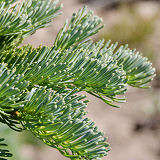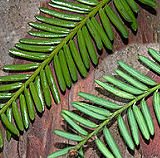Conifers
Others
——————
|
Overview of Northwest Conifers
The conifers
native to the Pacific Northwest are members of
just three botanical families:
- The Pine family
(Pinaceae) - includes
these conifer groups or genera:
- Douglas fir (Pseudotsuga) curiously
stands alone, as noted below.
- Hemlock (Tsuga) - 2 species
- Fir (Abies)
- 6 species
- Pine (Pinus)
- 8 species
- Spruce (Picea)- 3 species
- Larch (Larix) - 2
species
- The cypress family
(Cupressaceae) - includes the 4 species
commonly called
"cedar," a cypress, two junipers, and the Redwood.
- The yew family
(Taxaceae) - includes just Pacific yew.
|

|
Douglas
Fir
(Pseudotsuga
menziesii)
Douglas fir
is by
far the most common conifer native to Oregon and
is distinguished as Oregon's state tree. But remarkably,
Douglas fir it is not a fir
at all. That is, it is not a member of the Abies
genus. It stands in a genus
by itself. It was classified as a
fir at
one
time, because it has resin blisters in the young bark like the true
firs. It
also has been classified as a pine, spruce, and
hemlock. The
scientific name for its genus reflects one of these
misclassifications: Pseudotsugameans
false hemlock. Undoubtedly,
its
presence everywhere throughout the Pacific
Northwest and its widespread use as lumber has contributed to the
confusion about its
classification. You can easily identify Douglas fir by its soft,
bottle-brush needles, by the unique
three-pointed bracts that protrude from the cones, and by the thick,
deeply-furrowed bark. Finally, Douglas Fir has unique pointed
buds visible during most of the year.
|

|
Hemlocks
(Tsuga)
The
Northwest has
two varieties of hemlocks. It is easy to
distinguish them from other native conifers by their short, flat
needles and by the drooping branches and drooping leaders at the
top of each tree. The cones have rounded scales
like Douglas fir, but don't have bracts protruding from them. You can
usually distinguish one hemlock
from the
other by elevation, although their ranges overlap. Where they do
grow together, the needle arrangement and cone size will show the
difference. Tsuga
is the Japanese word for hemlock.
Western
Hemlock
(Tsuga
heterophylla) - Has short,
flat
needles and 3/4 inch cones.
Mountain
Hemlock
(Tsuga
mertensiana) - Has short
irregular needles and 2 inch cones.
|

|
True
Firs (Abies)
The
expression "true fir" distinguishes the firs from Douglas fir. The
cones of the firs are
perched on the top of the
upper branches, and fall apart at maturity, leaving a cone core spike
on the branch. So you won't
find any fir cones lying under the trees unless a squirrel cut them
loose and
dropped them. The bark
is smooth with resin blisters on younger stems and has furrows between
smooth plates on larger trunks. The needles lie in flattened rows or
curve upwards. All the needles of Northwest
firs come to a point that is soft and not prickly. Finally, when the
needles fall off, they leave round, flat scars on the twig. The
scientific name of the
genus
is from the Latin abeo,
which means "to rise." These firs are native to the Northwest:
Grand
Fir (Abies grandis)
- Has flat needles that lie flat.
Noble
Fir (Abies procera)
- Has needles shaped like hockey sticks.
Pacific
Silver
Fir
(Abies
amabilis) - Has flat needles
that point up.
Subalpine
Fir
(Abies
lasiocarpa) - Has needles with white
lines above and below.
These firs grow in
southwestern Oregon:
White Fir
(Abies
concolor) - Long
needles with white lines above and below. In Oregon, it grows as a hybrid with grand fir.
Red
Fir
(Abies
magnifica)
- Rare. Similar
to Noble fir, but
has no whiskers on its cones. In Oregon, it grows as a hybrid with noble fir.
|

|
Pines (Pinus)
Although pines are the
most common conifer throughout the
world, they don't compete as well in the climate of the Northwest,
where forests are dark, damp, and dense. You will find them high in the
mountains in more open forests and east of the Cascades where the
weather is dry. Pines
have
long needles that
grow in
bundles. You can usually identify a pine by the number of needles
in each bundle. The cones are the largest you will find in the
Northwest. Unlike the thin scales on hemlock and spruce cones, pine
cones
have thick, woody scales. Pinus,
of course, means "pine tree." Four
species of pine grow throughout the mountains of the Northwest:
Ponderosa
Pine
(Pinus
ponderosa) - Has bundles of 3
needles.
Lodgepole
Pine
(Pinus
contorta) - Has bundles of 2
needles. Also grows along the coast.
Western
White Pine
(Pinus
monticola) - Has bundles of 5
needles.
Whitebark
Pine
(Pinus
albicaulis) - Has bundles of
5
needles and grows near the timberliine.
These pines grow in the
mountains of
southwestern Oregon:
Jeffrey
Pine
(Pinus
jeffreyi) A 3-needle pine similar
to Ponderosa Pine but with larger cones.
Knobcone
Pine
(Pinus
attenuata) -
A 3 needle pine with short needles.
Sugar
Pine
(Pinus
lambertiana) -
A 5-needle pine similar
to Western White Pine but with larger, straighter cones.
This rare pine grows in the high elevations of the
Wallowa Mountains:
Limber Pine (Pinus Flexilis) - A
5-needle pine similar to Whitebark Pine.
|

|
Spruces
(Picea)
The
Spruces are
easy to
identify. The needles look like Douglas fir needles, but they are
pointed and
sharp. Unlike Douglas fir and the true firs, each spruce needle grows
on a small peg. These unique pegs remain even after a branch loses its
needles. The cones have paper-thin scales. The bark is gray and breaks
into scales on large
trees. Picea
is derived from the Latin for
"pitch." Three
species
of spruce grow in
the Northwest:
Sitka
Spruce
(Picea
sitchensis) - Grows along the
Pacific Coast.
Engelmann
Spruce
(Picea
engelmannii) - Grows high in
the Cascades.
Brewer
Spruce
(Picea
brewerana)
- Rare. Grows in
southwestern Oregon.
|

|
Larches
(Larix)
Unlike most conifers,
larches are deciduous, dropping
their needles in the fall. The needles grow in bundles like the pines,
but they have many more needles per bundle, and each bundle grows on a
distinctive little spur twig. Two species of larch grow in the
Northwest:
Western
Larch
(Larix
occidentalis) - Grows on the
east side of
the Cascades.
Alpine
Larch
(Larix
Lyallii) - Grows high in the
North Cascades of Washington.
|

|
New
World Cedars
The
cedars of North
America are called "new world cedars" to distinguish them from the
dissimilar, "true
cedars" of
the Himalayas
and the Mediterranean region. Thus, some
writers
call our native cedars "false cedars." However, these trees
are
commonly referred to as just "cedars," even though our northwest cedars
belong to four
different genera, none being Cedrus,
the genus of true cedars. All these new world cedars have
similar
looking
flat, scale-like leaves, and somewhat similar stringy bark. And they
all belong to the Cypress family (Cupressaceae).
Although these new
world
cedars grow in the Pacific Northwest, only western red cedar is
common:
Western
Red Cedar (Thuja
plicata) - Grows throughout western Oregon and Washington,
mostly in wet areas.
Incense
Cedar (Calocedrus
decurrens) - Grows in
the
Cascades south of Mt. Hood.
Alaska
Cedar
(Callitropsis nootkatensis) -
Grows high in
the Cascades.
Port
Orford Cedar
(Chamaecyparis
lawsoniana) - Grows
along the southern Oregon Coast.
|

|
Other Cypress Family Conifers
The following members of the cypress family also
grow in the Northwest:
Modoc
Cypress
(Cupressus bakeri) - Rare. The only cypress native to the
Northwest.
Western
Juniper (Juniperus
occidentalis) - Grows across much of eastern Oregon.
Rocky
Mountain Juniper (Juniperus
scopulorum) - Grows in central Washington.
Redwood
(Sequoia sempervirens) - Grows along the coast from Oregon to
central California.
|

|
Yew
(Taxus)
Yews are unique among the conifers. Yew seeds are
enclosed in small red berry-like fruit, called an "aril." Because yews
seem to lack proper cones, their status as a conifer has been
questioned, in spite of the obvious similar appearance of the needles.
Recent research has led some botanists to describe the arils as highly
modified cones. The needles are dark green on top and light green
underneath. The distinctive papery bark is brown or red. Just one
species of yew is native to the Pacific
Northwest.
Pacific
Yew
(Taxus
brevifolia) grows in shady locations at low to
medium elevations.
____________
Pronunciation
Guide
|
© 2012 Ken Denniston
|









